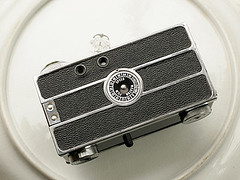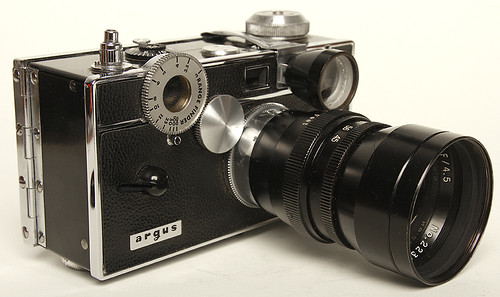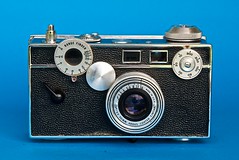Difference between revisions of "Argus C3"
| Line 29: | Line 29: | ||
== Construction == | == Construction == | ||
The C3 is made of bakelite and metal framings, with the front and rear panels covered in leatherette. True to nickname, the C3 is quite brick-shaped; heavy and hard to hold, but surprisingly compact for a budget 35mm camera from the period. Indeed, for a small, low-priced camera, it has a decent range of features, allowing professional results from a well-adjusted, competently used example. One way the engineers of the C3 kept these systems compact and cheap to manufacture was by simplifying each mechanism as much as possible. Sometimes this requires the photographer to be more knowledgeable about his or her camera to achieve the same results, but it brought quality photography to the masses in a small package, at any rate. | The C3 is made of bakelite and metal framings, with the front and rear panels covered in leatherette. True to nickname, the C3 is quite brick-shaped; heavy and hard to hold, but surprisingly compact for a budget 35mm camera from the period. Indeed, for a small, low-priced camera, it has a decent range of features, allowing professional results from a well-adjusted, competently used example. One way the engineers of the C3 kept these systems compact and cheap to manufacture was by simplifying each mechanism as much as possible. Sometimes this requires the photographer to be more knowledgeable about his or her camera to achieve the same results, but it brought quality photography to the masses in a small package, at any rate. | ||
| − | |||
{{Flickr_image | {{Flickr_image | ||
| Line 80: | Line 79: | ||
| image_size=large | | image_size=large | ||
}} | }} | ||
| − | |||
{{Flickr image | {{Flickr image | ||
| image_source= http://www.flickr.com/photos/49656291@N00/3685290005/in/pool-camerawiki | | image_source= http://www.flickr.com/photos/49656291@N00/3685290005/in/pool-camerawiki | ||
Revision as of 01:27, 13 August 2018
| Argus C3 |
|---|
|
Manufacturer: Argus
Film type: 135 (35mm film)
|
The Argus C3 rangefinder camera was introduced by Argus in 1939. It was a minor revision of the Argus C2, adding flash sync sockets to the side of the camera. However this model became Argus's runaway success story, staying in production through 1966 with only minor changes. Fondly known as "the Brick," the camera brought 35mm rangefinder photography down to a price affordable by amateurs who could not dream of owning a Leica or Contax.
Construction
The C3 is made of bakelite and metal framings, with the front and rear panels covered in leatherette. True to nickname, the C3 is quite brick-shaped; heavy and hard to hold, but surprisingly compact for a budget 35mm camera from the period. Indeed, for a small, low-priced camera, it has a decent range of features, allowing professional results from a well-adjusted, competently used example. One way the engineers of the C3 kept these systems compact and cheap to manufacture was by simplifying each mechanism as much as possible. Sometimes this requires the photographer to be more knowledgeable about his or her camera to achieve the same results, but it brought quality photography to the masses in a small package, at any rate.

|
| The Argus C2, left, lacked the flash-sync sockets of the C3, right image by Rick Oleson (Image rights) |
Indeed, the difference between American and German engineering culture is apparent when comparing the Argus to a Leica or Contax: where the German cameras are detail-oriented and heavy on miniaturization and added features, the Argus designers emphasized the big picture, compromising individual features to build a functional, cheap camera that many could afford and most could service with simple tools. In this and many other ways, the C3 is comparable to another famous American rangefinder from the same time period, the Kodak Medalist.
The C3 has a three-blade behind-lens leaf shutter built into the body of the camera so that it could utilize interchangeable lenses without the need for a complex and delicate focal plane shutter. The number of speeds and the specific ones available both depend on the year of manufacture. Damage to the shutter can result if the shutter-speed selector wheel is repeatedly turned clockwise, or forced clockwise past the one-way catch between 1/10 and 1/300. The shutter is manually cocked by a lever on the camera front. If this lever is stopped by the fingers as it springs back when the shutter fires, the shutter will remain open too long, as the lever is connected directly to the moving parts of the shutter mechanism.
In a fine example of Argus simplicity, the bulb exposure works independently of shutter speed, by pausing the shutter mechanism with a simple mechanical catch. Bulb exposure is activated by turning the base of the shutter-release.
The standard lens is an f3.5 Argus Cintar 50mm, with focus from 3 feet to infinity. The lens is set in a screw-mount that also functions as the focusing helicoid. The lens is removed by removing the gear between the lens and rangefinder, allowing the lens to be turned past the 3-foot mark and unscrewed, and mounted by screwing it all the way in, setting the rangefinder to infinity, and inserting back the gear. The aperture diaphragm is controlled by a ring on the lens front. A telephoto lens and a wide-angle lens were manufactured by third parties, and prototypes of other lenses exist.

|
| 1941-1944 model C3 with 7-speed shutter image by Siim Vahur (Image rights) |

|
| C3 back image by Siim Vahur (Image rights) |
The rangefinder and viewfinder are separate, viewed through two round windows on the back plate. The rangefinder is a split-image type, with a relatively short base and a relatively low magnification (or none at all in earlier examples). In most C3's, the lower half of the rangefinder image is tinted by a coloured filter, apparently to make the break between the halves easier to spot. Combined with the mirroring system, which often becomes darkened with age, this filter can make the rangefinder rather murky and dim. Late in the camera's run the filter was changed from blue to yellow. The gearing connecting the rangefinder and the lens is another mechanically simple and robust piece of engineering, allowing the photographer to reliably synchronize the two when mounting a lens.
Film transport is from right to left, unlike many 35mm cameras. The advance knob is on the top plate, while the rewind is diagonally opposite it on the bottom, paired with a dummy knob for symmetry. On this fake knob is the tripod bushing. A small peg forms a rudimentary tripod with these two knobs, allowing long exposures to be made without an external mount.
The advance mechanism and exposure counter are of a remarkably simple type. The sprocket gear is locked until manually released, and the exposure counter is just a wheel geared to turn slightly more than a full turn for every frame, with another wheel marked 0-35 loosely mounted on top of it, so that the photographer can turn it to read zero at the beginning of a roll. The advance mechanism does not lock the film from rewinding at any time, so care must be taken not to turn the rewind knob before the end of a roll, or overlapping frames will result.
Due to the extreme simplicity of most of the camera's mechanisms, many examples, even early ones, still function, so there is a vibrant community of users even in the present day, as evidenced by the number of online resources devoted to this camera.

|
| C3 with Fujitar 135mm f4.5 lens and clip-on viewfinder accessory lens image by Rick Soloway (Image rights) |

|
| Inside construction image by Kenneth Dwain Harrelson (Image rights) |
Links
- The Argus Collector's Group
- Argus C: the first best-selling 135 film camera (1938), at DCView (in Chinese, English translation)
- Manual for accessory lenses available on the Favorite Classics section of .kyphoto.com
- The Other Martin Taylor's review of the Argus C3
- Argus C3 Camera Manual (PDF) : Photo-Manuals.com
- manual at Michael Butkus Jr.'s
- Argus C3 at www.collection-appareils.fr by Sylvain Halgand (in French)
- changes of the C3 from 1939 to 1957 at photo.net
- serial numbers of C3 types at vieilalbum.com
- Argus C3 page, English version at Ken.Lyndrup.dk
- Argus C3 page, Dansk udgave at Ken.Lyndrup.dk (in Danish)
- Argus C3 at whitemetal.com
- When was my Argus camera made?, by Phillip G. Sterritt, at Argus Camera Information Reference Site
- Gustave Fassin's Argus C Patent, at Google Books
- Argus C3 and photos taken with it
- Argus C3, by Daniel Jiménez, at From the focal plane to infinity
